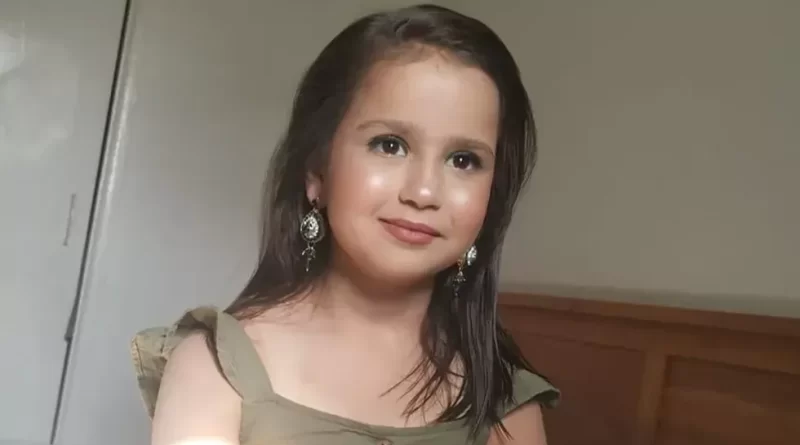At least 70 ‘new’ injuries found on Sara Sharif’s body as details revealed by forensic pathologist
Sara Sharif had at least 70 “new injuries” when her body was found, a jury has heard.
Forensic pathologist Dr Nathaniel Cary, who gave evidence this morning at the Old Bailey, talked the Old Bailey through the dozens of injuries he recorded.
On the third day of the murder trial for the death of the 10-year-old girl, Dr Cary guided the court through the bruises, marks and scars — both old and new — that covered the girl’s body from “head to toe”.
The 10-year-old girl was allegedly murdered after enduring weeks of violence by her father Urfan Sharif, 42, her stepmother, Beinash Batool, 30, and her 28-year-old uncle Faisal Malik.
Sara’s body was found in a bunk bed at the family home in Woking on August 10 last year, where she displayed injuries such as bite marks, scalding and broken bones.
Jurors previously heard that Sara endured two years of a “campaign of abuse,” where she suffered spinal fractures, burns caused by a domestic iron, brain injuries, and that she also faced hooding secured by adhesive tape.
A bloodstained cricket bat, belt, rope and a vacuum with Sara’s DNA were found near the family’s outhouse.
Lead counsel for the prosecution, William Emlyn Jones KC, questioned Dr Cary, who confirmed that he gave an initial post-mortem examination on Sara Sharif on August 15, which took three hours.
He recorded Sara’s height as 4”6’. At the time of her death, she weighed 27kg, which the prosecuting barrister said that Sara was “right at the bottom” of the normal range of weight for a girl of her age.
Dr Cary also confirmed that there was no indication of any natural disease that contributed to Sara’s death.
The pathologist added that he had made “many dozens” of photographs of external injuries.
A set of graphics were made to display the injuries, demonstrating their “location and feature.” The injuries heard by jurors today included scarring, bruising, and a “gaping” head injury.
Emlyn Jones took the court through the injuries in order as they were numbered from head to toe.
Dr Cary said some of the injuries were endured within a few days of Sara’s death. He also pointed to some scarring, indicating injuries that were older.
Starting with old injuries, Dr Cary pointed out blotchy small scarring on her left jaw and a relatively small scar to the right of the middle of her lower chest.
Next, he detailed an old injury just below the left side of Sara’s pelvis, which were “multiple parallel scars,” at least three in number with some others dotted above them, up to 3cm circumferentially and 2mm longitudinally.
There was also scarring on her right side, up to 7cm long, with “multiple marks”, which Dr Cary said were “healed sharp injuries”.
LATEST DEVELOPMENTS:
‘Clueless!’ Home Office seeking even MORE hotel spaces for illegal migrant crossings‘It beggars belief!’ Sadiq Khan ABANDONS promise to investigate preacher adsBoy, 7, dies after ‘devastating explosion’ and major housefire in Newcastle
Moving to her legs, Emlyn Jones detailed some “hyperpigmentation”, which Dr Cary said was an exaggerated colour to the skin which can be caused by “trauma” to the knee.
They also referred to blotchy hyperpigmentation to the outside of Sara’s left lower leg, which ran to the top of the foot in three main areas.
Sara also had a scar over the back of her right Achilles region, which also had an area of hyperpigmentation.
On the back of the left Achilles, there was also a scar and some hyperpigmentation.
There was also “blotchy brown discolouration” on the back of her left forearm, which Dr Cary said was probably originally bruising.
Jurors heard that there were more obvious scars over the base of her left thumb and around the forearm. There were scars 13cm in length and 4cm across around the bands of her wrist.
The prosecution then turned to more recent injuries.
Dr Cary referred to a sharp or semi-sharp “gaping” puncture wound on her head, where the edges are still apart. This injury had not healed, it was fresh enough to still be open at her time of death.
A triangular mark on the edge of her right eyebrow was described as an abrasion, caused by a “scraping effect”.
There was also “confluent” purple bruising to the back of her right cheek, 4.5cm by 2cm. Dr Cary explained that “confluent” bruising is when the injury is consistent, not caused by multiple little bruises.
He then covered a “bluish bruise” to the front of the right ear, another “relatively deep” abrasion on the bridge of the nose, and a “superficial abrasion” mark on the jaw.
On the next page of injuries, the prosecution referred to bruising on the top of her head and “irregular” bruising up to 4cm further down.
Emlyn Jones pointed out bruising behind the right ear.
They then turned to another page of injuries, which showed Sara’s head from behind.
There were small abrasions to the flap of each ear, and at the top of the back of her head, there was bruising up to 5 by 6cm.
Moving round to the head from the left-side-on, the prosecuting barrister pointed to an irregular shaped area of bruising from the left eye backwards and slightly upwards to the temple, 5 by up to 2.5cm.
Dr Cary said it involved the “lateral area of the left eye” in his pathology report.
The next injury was two “dot abrasions” to the corner of her mouth, which Dr Cary said was a very localised skin trauma.
Injury number 12 was an area of bruising to the left ear, described as “confluent”, from the front to the back of the area, which Dr Cary said, “could well have been [caused by] one point of impact.”
LATEST DEVELOPMENTS:
Alex Salmond: RAF’s refusal to repatriate body forces John Swinney to pay for chartered flightMurder probe launched after schoolboy, 8, disappeared more than 6 weeks agoEuthanasia bill could lead to a dystopia for the vulnerable, warns Archbishop of Canterbury
The next injury was an area of “patchy bruising” to Sara’s hairline and further bruising further up the 10-year-old girl’s head.
On the next page, the pathologist assessed a “linear abrasion” to Sara’s mouth.
They then moved to the front of Sara’s torso to assess more injuries.
Dr Cary’s report referred to “intense” bruising to the top of the chest and both shoulders, which approached the neck on both sides, the result of “blunt impact or solid pressure or both”.
These wounds were 27cm across, from shoulder to shoulder, and 13cm from the neck to the middle of her chest. The colour of the bruising has been captured in the graphic, showing the “intensity” of it.
In the middle of Sara’s chest was a “transverse linear abrasion,” a side-to-side injury, and then just below it another similar wound.
Dr Cary said the passage of time from death to examination may have affected the colour of the wounds.
Injury number 21 dealt with a larger area collectively, a “green bruise” just to the right of the midline of Sara’s upper abdomen, which ran side-to-side 4.5cm long and 1.5cm tall, just above her “tummy button”.
Below that was a “cluster” of green and blue bruises around her “tummy button,” which involves an area of bruising totalling 8cm by 11cm, in a rough circle around the tummy button.
Below there were “oblique” bruises with tram-tracked features, which Dr Cary said was often seen when people were “struck with an elongated object.” He said that the damage was often greatest in the middle — in the pale area — but the bruising arrived at the edge of the point of impact. There were three such areas on Sara’s body at that part of her abdomen.
Injuries 22 and 23 were “purple-ish” bruising, similar to the “intense purple-ish red” bruising seen on her shoulders.
Above this was a “greenish discolouration” of bruising on Sara’s body.
The next page of modelled injuries showed Sara’s back.
Injuries 25 and 26 were bruising to the right side of her back, injury 27 was “faint red discolouration” on the lower back.
On her right buttock, there was a hole underneath where the skin should be, and on her left buttock was a “deep ulcer”, both of which Dr Cary said were caused by burns.
Page eight of the injury modelling showed Sara’s legs.
Emlyn Jones pointed to four labels down the side of her left leg, adding that there were “many more” than four bruises, but they had been clumped together for the purpose of referring to them.
LATEST DEVELOPMENTS:
Conkers competition descends into farce as men’s champion found with STEELBoots posts sales surge despite company closing 1,200 storesPensioners protest Winter Fuel Payment axe at Downing Street
There were also blunt impacts to the legs creating several marks.
On the inside of the left thigh, injury 33 was detailed as “blotchy red discolouration,” which Dr Cary said was “probably” a form of bruising.
The next set of injuries were burns where the skin had been removed over the inside of her left ankle.
There were also marks on her toes, and “skin break down and flap”, which Dr Cary said signified blistering.
There were then more tram track injuries recorded on the right leg and at least three areas of blanching, where blood is “squeezed out” from the point of impact and bruising occurs on the edges.
On page 12 of Sara’s injuries, there were more bruises on the right knee and the back of the leg, where a “healing abrasion” was recorded.
There was also “wraparound” and “close to parallel” bruising around Sara’s calf.
Emlyn Jones then moved to injuries to Sara’s arms, where more bruising and “blotchy hyperpigmentation” was described.
Concluding evidence of the recent injuries, there were at least 71 injuries recorded, the court heard, but Dr Cary said that it was not a “total figure.”
All three defendants appeared emotionless in court as the extensive injuries were listed. Beinash Batool sat with her head bowed.
The defendants have pleaded not guilty to Sara’s murder and to causing or allowing the death of a child between Dec 16 2022 and Aug 9 2023.
The trial continues.

